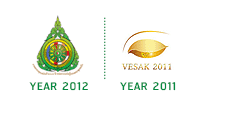05/24/13
Filed under:
General
Posted by:
site admin @ 7:16 am
930 LESSON 25-05-2013 SATURDAY-FREE ONLINE eNālāndā Research and Practice UNIVERSITY-
Happy Vesak - People all over the world hope our Raj Bhavan, Parliament, Rajya Sabha, The White House, and all our Media celebrate Buddha Jayanthi in a grand manner for the Welfare, Happiness and Peace of the entire people.
Please watch
http://archive.org/details/BuddhasLifeAnimation2007Thai_201303
for
Buddha’s Life Animation ( 2007) Thai (March 25, 2013)
Buddha life Cartoon Animation
1Hr. 38 Mins
http://archive.org/details/KimClarkBuddha_sTeachingonLoving-KindnessforA synopsis of the Buddha’s world view is followed by a hauntingly
beautiful rendition of his teaching on Loving-Kindness, the Metta Sutta.
6.21 mins
http://in-mg61.mail.yahoo.com/neo/launch#mail
[Attachment(s) from vinaya rakkhita included below]
|
Dear All,
Wish You All Happy Budddha Jayanthi /UN Vesak - 2013 CE/2556 BE
February 2nd, 2013 by david
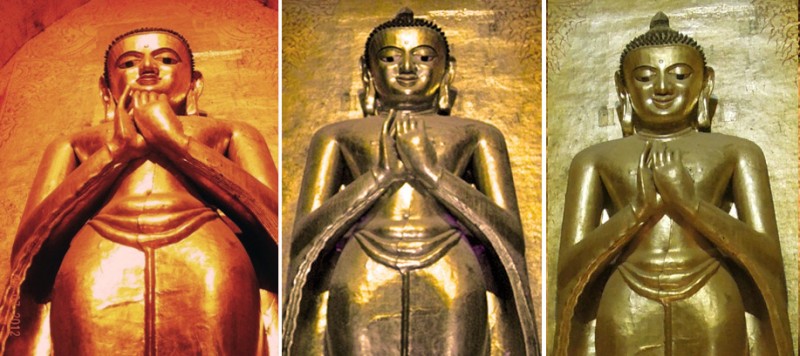
In this wonderful image of the Buddha from
Bagan, Myanmar, facial expression changes from stern through smiling to
radiant as the figure is viewed from increasing distance. According to
my friend Eddy Keon, the highest status members of the temple audience,
along with temple officials, would have stood closest to the Buddha and
therefore have experienced him at his sternest, whilst his radiance
increased with the poverty of the viewer, banished to the back of the
crowd.
The figure is the Kassapa Buddha, one of four Buddhas in the Ananda Temple, Bagan, Myanmar.
The city was the capital of the ancient Pagan kingdom, built, along
with the temple and this figure of the Buddha, eight hundred years ago.
The left hand and centre photos are from the brilliant travel blog of Forrestwalker.
The right hand image was taken by Eddy Keon. His photo is so
beautiful, here’s the whole thing. Eddy hopes to use his pictures to support a hill village school in Myanmar.
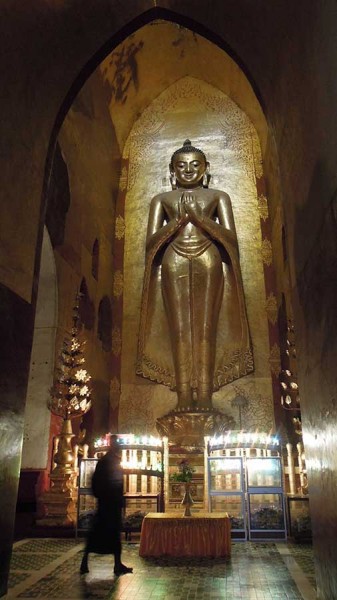
http://www.desktopnexus.com/tag/buddha/
http://abstract.desktopnexus.com/wallpaper/1459670/
Zen meditation

http://architecture.desktopnexus.com/wallpaper/1432375/
http://nature.desktopnexus.com/wallpaper/1414891/
http://www.undv.org/vesak2013/en/aboutundv.phpwith metta,
Bhanteji
|
__._,_.___
Attachment(s) from vinaya rakkhita
1 of 1 Photo(s)
 |
 |


| |
Story of each Vesak Celebrations
History of UN Day of Vesak Celebrations
International Council of the United Nations Day of Vesak
International Association of Buddhist Universities
Officers and Location
Background & Objectives
on The International Celebration on the Occasion of United Nations Day of Vesak
|
|
|
|
|
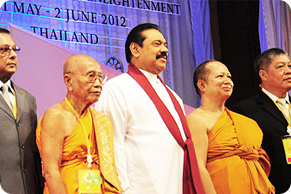 |
International Buddhist Conference on the United Nations Day of
Vesak At Conference Hall Mahachulalongkornrajavidyalaya University,
Main Campus, Wang Noi, Ayutthaya and United Nations Conference Centre,
Bangkok, The Kingdom of Thailand 31 May – 02 June 2012 /2555
Participants : 5,000 Buddhist leaders, scholars, delegates and observers from all over the world are expected to attend the conference.
|
|
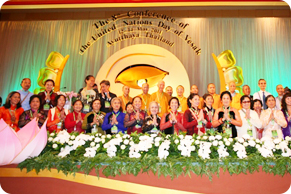 |
International Buddhist Conference on the United Nations Day of
Vesak At Conference Hall Mahachulalongkornrajavidyalaya University,
Main Campus, Wang Noi, Ayutthaya and United Nations Conference Centre,
Bangkok, The Kingdom of Thailand 12-14 May 2011/2554
Participants : 5,000 Buddhist leaders, scholars, delegates and observers from all over the world are expected to attend the conference.
|
|
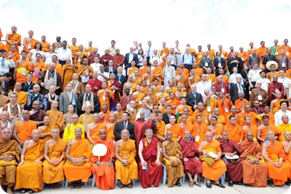 |
International Buddhist Conference on the United Nations Day of
Vesak At Conference Hall Mahachulalongkornrajavidyalaya University,
Main Campus, Wang Noi, Ayutthaya and United Nations Conference Centre,
Bangkok, The Kingdom of Thailand 23-25 May 2553/2010
Participants : 5,000 Buddhist leaders, scholars, delegates and observers from all over the world are expected to attend the conference.
|
|
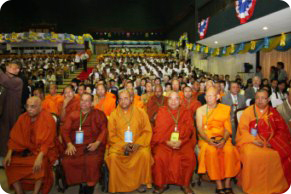 |
International Buddhist Conference on the United Nations Day of
Vesak At Conference Hall Mahachulalongkornrajavidyalaya University,
Main Campus, Wang Noi, Ayutthaya and United Nations Conference Centre,
Bangkok, The Kingdom of Thailand 4-6 May 2552/2009
Participants : Over 2,000 Buddhist leaders, scholars and delegates from all over the world are expected to attend the conference.
|
|
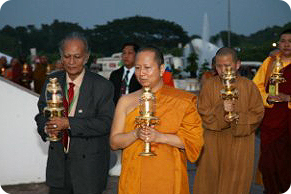 |
Between 18-19 May 2008, Mahachulalongkornrajavidyalaya
University and ICDV,hosted the 2nd International Buddhist Conference on
the United Nations Day of Vesak at Buddhamonthon Conference Hall ,
Nakhon Pathom Province, The Kingdom of Thailand.
Emphasis : The emphasis of the conference was to
promote and support sustainable development; resolve that Buddhamonthon,
The Kingdom of Thailand should be recognized as the Center of world
Buddhism; play a leading role in coordinating between Buddhist
institutions and in promoting and sharing Dhamma resources.
|
|
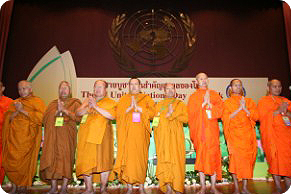 |
Between 26 – 29 May 2007, Mahachulalongkornrajavidyalaya University, in
conjunction with ICDV and the Sangha Supreme Council hosted the 4th
International Buddhist Conference on the United Nations Day of Vesak at
Buddhamonthon, Nakhon Pathom Province, and at the United Nations
Conference Centre in Bangkok, The Kingdom of Thailand.
Participants : Over 2000 Buddhist leaders, scholars and delegates from all over the world are expected to attend the conference.
Emphasis : This year’s conference emphasizes Buddhism
and good governance, and marks the Auspicious Occasion of His Majesty
King Bhumibol Adulyadej’s 80th Birthday Anniversary.
|
|
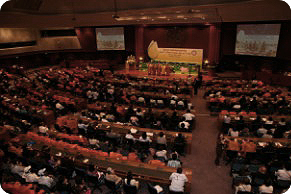 |
Between 7 – 10 May 2006, Mahachulalongkornrajavidyalaya
University and ICDV, in conjunction with the Sangha Supreme Council and
the Thai Government hosted the 3rd International Buddhist Conference on
the United Nations Day of Vesak at Buddhamonthon, Nakhon Pathom
Province, and at the United Nations Conference Centre in Bangkok, The
Kingdom of Thailand.
Emphasis : The conference emphasized world peace,
cooperation between all schools of Buddhism, sustainable development,
and the sufficiency-economy theories of H.M.King Bhumibol.
|
|
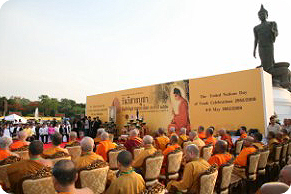 |
Between 18-21 May 2005, Mahachulalongkornrajavidyalaya
University and ICDV,hosted the 2nd International Buddhist Conference on
the United Nations Day of Vesak at Buddhamonthon Conference Hall ,
Nakhon Pathom Province, The Kingdom of Thailand.
Emphasis : The emphasis of the conference was to
promote and support sustainable development; resolve that Buddhamonthon,
The Kingdom of Thailand should be recognized as the Center of world
Buddhism; play a leading role in coordinating between Buddhist
institutions and in promoting and sharing Dhamma resources.
|
|
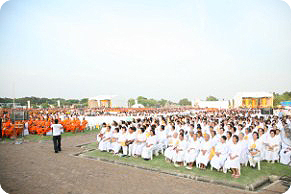 |
On 25 May 2004, Mahachulalongkornrajavidyalaya University and ICDV
held the World Buddhist Leaders Conference on International Recognition
of the Day of Vesak at Buddhamonthon Conference Hall , Nakhon Pathom
Province, The Kingdom of Thailand.
Emphasis : The emphasis of the conference was to study,
practice, propagate and protect Buddhism and to jointly organize the
Vesak Day celebration at the United Nations Headquaters and at the UN
regional offices.
|
|
|
 |
 |
Friends:
At this Fullmoon Day do all Buddhas Awaken:
24th May 2013 Vesak Day celebrates birth, Enlightenment, and passing away
of the Buddha Gotama. Rejoice! Keep clean, calm, cool, clever, and caring…
About this Buddhist Vesak Festival: http://en.wikipedia.org/wiki/Vesak
This May full moon also celebrates the Buddha’s third visit to Sri Lanka in
the eighth year after his Enlightenment, where he journeyed to Kelaniya on
the invitation of the Nāga King Maniakkhika (Mahavamsa i,72ff.).
The day also celebrates the crowning of king Devānampiyatissa (Mhv.Xi.42),
and the laying of the foundation stone of the Mahā Stūpa (Mhv.Xxix.1)
Please Remember:
At this very May full moon in year 528 BC the Blessed Buddha awakened
by completely perfect and utterly unsurpassable self-Enlightenment!
At that time a girl named Sujata Senani lived in Uruvela. When adult she
prayed before a certain Banyan tree, that she might get a good husband
equal to herself in caste & that her firstborn may be a son. Her prayer was
successful. Since indeed it did happen. At the full moon day of the Wesak
month, she rose at early dawn and milked the cows. As soon as new buckets
were placed under the cows, the milk poured spontaneously in streams all by
itself! Seeing this miracle, she knew something special was happening!
That same night the Future Buddha dreamt 5 dreams making him conclude:
“Surely, truly, without any doubt, today I will reach perfect Enlightenment!”
His 5 colored radiance illuminated the whole tree. Then Sujata came and
offered the cooked milk rice into the hands of this Great Being.
Later a local grass-cutter came going with a bundle of grass just harvested
from nearby. He offered the Great Being 8 handfuls of Kusa grass, when he
saw that this Sage was a Holy Man. The Future Buddha accepted the grass
and proceeded to the foot of the Bodhi-tree. Reaching the imperturbable
Eastern side, where all the Buddhas take their seat, he sat down saying to
himself: This is the immovable spot, where all the prior supreme Buddhas
have planted themselves! This is the place for destroying this net of desire!
Then the Future Buddha turned his back to the trunk and thus faced east.
Right there, he then resolutely settled on this mighty decision:
Let just blood and flesh of this body dry up & let skin and sinews fall from
the bones. I will not leave this seat before having attained the absolute and
Supreme Self-Enlightenment!
So determined did he seat himself in this unconquerable seat, from which
not a 100 lightning strikes could make him waver. At this very moment
the rebel deity Mara -The Evil One- raised exclaiming: Prince Siddhattha will
pass beyond my power, but I will never allow it! And sounding the Mara’s war
shout, he summoned his mighty army for battle. Then Mara warned his evil
militia: This Sakyamuni, son of Suddhodana, is far greater than any other
man, so we will never succeed to fight him up front. We must thus attack
him from the rear. Frustrated, being unable even to touch this big wielder
of power also with 9 mighty hurricanes of wind, rain, rocks, weapons, red
coals, hot ashes, sand, mud, and darkness Mara somewhat in panic shouted
at his army: “Why do you all stand still? Seize, kill & drive away this prince!”
Mara then yelled: “Siddhattha, leave this seat. It is not yours, but mine!”
Hearing this, the Well-gone One replied: Mara, neither have you fulfilled the
10 perfections to the third degree, nor have you given the 5 great donations.
Neither have you striven for insight, nor for the welfare of all the world,
nor for supreme self-enlightenment! Therefore does this very seat surely
not belong to you, but truly indeed only to me. Suddenly overpowered by fear
Mara’s followers fled helter-skelter in all directions. No two went in the
same direction, but leaving their weapons in a chaos, they all fled terrified
by metaphysical panic. Seeing them flee thus, the great assembly of deities
triumphantly shouted: Mara is defeated. Prince Siddhattha has won! Let us
celebrate this truly sublime, wonderful and unique victory! It was before
the sun had set that the Tathagata conquered Mara and defeated his army.
That same night, after having bathed, while the Bo tree rained red sprigs onto
his robe, The Consummate One gained knowledge of his prior lives during the
1st watch of the night: “With the mind thus concentrated, purified, bright,
unified, focused, tractable, compliant, steady & imperturbable, I directed
mind to remembrance of my past lives. I recollected many past lives, i.e., one
re-birth, two…five, ten… 50, a hundred, a thousand, 100 thousand, many eons
of cosmic contraction, & many eons of cosmic expansion: There I had such
a name, belonged to such a clan & species, had such a body. Such was my food,
such my life of pleasures and pains. Such was the end of my life. Passing away
from that state, I re-arose there. There I had such name, belonged to such
a sort & family, had such a form. Such was my food, such my experience of
pleasures & pains. Such was the end of my life. Passing away from that state,
I re-arose here. Thus I remembered my various past lives in all their various
modes and manifold details. This was the first knowledge I attained in the
first watch of the night. Ignorance was destroyed; the knowledge arose;
darkness was destroyed; light arose as happens in one who is alert, aware,
and determined. But the very pleasant feeling that arose by this did neither
invade my mind, nor remain. With the mind thus concentrated, purified, bright,
intact, pliant, malleable, steady, and totally imperturbable, I directed it to
the knowledge of the passing away and reappearance of beings. I saw by
means of the divine eye, purified & surpassing the human eye! I saw beings
passing away & re-appearing, and I realized how & why they are high or low,
beautiful or ugly, fortunate and unfortunate all in exact accordance with
the intentions of their prior actions: These beings who were endowed with
bad behaviour of body, speech, and mind, who reviled the Noble Ones, held
wrong views & acted under the influence of wrong views, with the break-up
of the body, after death, have re-appeared in the plane of misery, the bad
painful destination, the lower realms, even in hell. But the beings who were
gifted with good behaviour of body, speech and mind, who did not revile the
Noble Ones, who held right views and acted under the influence of right
views after the break-up of the body, after the death, have re-appeared in
happy destinations, even in a divine world! Thus by means of the divine eye,
purified and surpassing the human I saw beings passing away & re-appearing,
all in accordance with their particular mixture of good and bad kamma…
But the satisfaction that arose here did neither invade my mind, nor remain.
With the mind thus concentrated and completely absorbed, I then directed
it towards understanding the ending of mental fermentation. I realized how
it actually comes to be, that:
This is Suffering…
Such is the Cause of Suffering…
Such is the End of Suffering…
Such is the Way to End Suffering…
Such was the mental fermentations…
Such is the Cause of mental fermentation…
Such is the End of mental fermentation…
Such is the Way leading to the end of mental fermentation.
When my mind saw that, it was instantly freed of the fermentation of all
sense-desire, it was released from the fermentation of becoming, and it
became fully uncovered from the fermentation of ignorance. Thus fully and
perfectly Enlightened - The Buddha - perceiving this immense glory, spoke
these 2 solemn verses, which never has been omitted by any of countless
billions of prior Buddhas:
Through this round of countless existences have I searched, but yet failed
to find “the Creator”, who framed this construction: What Suffering indeed
is such endless birth, ageing, decay, sickness and ever repeated death!
Now I see that “the Constructor” of this structure is Craving…!!! Never shall
this construction be built again, since all the rafters are shattered and the
main beam is busted and completely broken… At this calming of all Craving,
the mind was finally, irreversibly and ultimately stilled…
Then, friends, this revelation of certainty arose in me: This release is indeed
immutable, this is the very last rebirth, this endless reappearance has finally
come to a happy end… Nibbāna is verily the Highest Bliss!
About Absolute Awakening!
http://What-Buddha-Said.net/library/DPPN/b/buddha.htm
http://What-Buddha-Said.net/library/DPPN/g/gotama.htm
http://What-Buddha-Said.net/library/DPPN/s/sujaataa.htm
http://What-Buddha-Said.net/library/DPPN/b/bodhisatta.htm
http://What-Buddha-Said.net/library/DPPN/wtb/b_f/bodhi.htm
http://What-Buddha-Said.net/library/DPPN/b/bodhirukka.htm
http://What-Buddha-Said.net/library/DPPN/b/bodhimanda.htm
http://What-Buddha-Said.net/library/DPPN/wtb/s_t/sammaa_sambodhi.htm
Good Picture video of the Gotama Buddha’s life:
http://www.youtube.com/watch?v=UrrmOR9suvc
Source:
The Jātaka Nidāna. The story of Gotama Buddha.
Tr. by N.A. Jayawickrama, Pali Text Society 1990.
http://www.pariyatti.com/book.cgi?prod_id=132935
VESAK FESTIVAL VIDEO, COLOMBO 2011:
http://www.youtube.com/watch?v=RLScBZ1tW0A
http://www.youtube.com/watch?v=7eunH6Dh2mM
Happy Vesak to All Beings!
Friendship is the Greatest!
http://in-mg61.mail.yahoo.com/neo/launch#mail
Dear JC,
Good morning.
Hope things are fine at religious, political and home fronts.
I appreciate and acknowledge receipt of your recent valuable Mails.
out of so you had been sending meticulously.
- 3d street pictures- Hats off to the artist for his brilliance.
- Banta and Beer
The latest covering the wonderful and World Famous Budha statues
and most importantly the concise brief life history of lord Budha
on the eve of Budha Poornima.
Thanks once again.
with warm regards.
Dr Bala
MISUSE OF EVM _ PART -12
•
• New voter verifiable paper trail (VVPT) machines to replace the EVMs, following doubts that it could be tampered.Voting Machines are “Calculators which can be manipulated by computer softwares”. New Machines are ordered by EC, where a paper slip will come out with EVM voting which will be then deposited in a box. What is the use? Paper Slip will show that voter has casted vote for “Party A”, but calculator software will add vote to “Party B”! The Computers are programmable. No use for such fake paper slips. In Superior Courts it has been demonstrated how these computers can be manipulated and how it can be pre-programmed to make sure victory to one candidate during election. The EVM machines have killed Democracy and have all the potentials to do so. The ruling castes are manipulating EVMs to make sure victory to them depriving the dipressed classes to enable them to acquire the MASTER KEY that can unlock all doors of progress to the entire people.
•
• Under such circumstances the following exposure by media had no relevance during the last Karnataka Assembly Elections 2013 where the Congress won and the trend will continue in the forth coming General Elections until the Superior Court and the upholders of Democracy including the free and fair media.
7.2 Open Source Business Models and the Voting Systems Market
The larger information technology and services sector has seen a substantial growth in business activity directly or indirectly tied to open source software. Is disclosed and open source software something that would naturally arise in the voting systems market? The voting technology market and regulatory environment are sufficiently distinct that a direct translation of current open source business models is questionable. Here, we cover what business models from other open source business endeavors might be applicable in the voting systems market. In Section , we highlight some barriers to entry and ongoing business that such an enterprise might face.
A few ways to make money off of open source software used in the IT sector might apply to the business environment surrounding voting systems. Firms such as 10X Software make money off of integrating IT systems into operating environments. A similar idea could be extended to voting, where a system integrator would incorporate open source voting system software and voting hardware to produce a voting solution for a state or local jurisdiction. Some firms, such as Wild Open Source, structure their business around targeted development of open source software. A software firm could be hired by a jurisdiction to add, fix or modify certain features of an open source voting system to their own specifications. This could ensure that specific functionality, such as supporting Instant Runoff Voting, was available in the technology that the customer was going to purchase. This also has the benefit that a feature could be added to the software before the open source voting system as a whole was certified and minimize the costs of having to re-certify a base system with the contracted modifications. Dual licensing is where a company offers the same software under two different software licenses, usually one being free software or open source and the other being a commercial license.76This can allow their product to benefit from some aspects of open source development while also allowing their customers, commercial and non-commercial, flexibility in their licensing options. For example, MySQL AB offers its MySQL database software freely under the terms of the GNU GPL, but also allows companies to purchase commercial licenses that permit them to deviate from the terms of the GPL. In the voting systems context, a vendor could offer its software for free under a disclosed or open source license, but then charge commercial users to build variants. Companies could use the open source software simply to sell their hardware. That is, with open source software running their voting hardware, they can devote more resources to ensuring that their voting hardware is innovative and as cutting-edge and economical as their customers demand. For example, to concentrate their efforts at selling their high-quality hardware, Apple computer has embraced open source software as the core of their Mac OS X operating system.77
Some ways that companies use to make money off of open source do not translate well to the voting systems market. For example, Google’s business strategy involves running optimized web search services on server clusters running the Linux operating system. Given the concerns and problems with networking in election systems, it would be difficult for a company to make money off of running open source voting software remotely. IBM sells proprietary software that works on top of or in concert with open source software. A company that tried to do this in the voting market would have to marshal each version of its software package through certification, and then it would only be partially open as a whole.
(Sekhiyà)
Ime kho panàyasmanto sekhiyà dhammà uddesaü àgacchanti.
[BJT Vol II (I), Page 488] [\x 488/]
Sekh 1: (Parimaõóalasikkhàpadaü) : 31
Parimaõóalaü nivàsessàmã-ti, sikkhà karaõãyà.
[BJT Vol II (I), Page 490] [\x 490/]
Sekh 2:
Parimaõóalaü pàrupissàmã-ti, sikkhà karaõãyà.
Sekh 3: (Suppañichannasikkhàpadaü):
Supañicchanno antaraghare gamissàmã-ti, sikkhà karaõãyà.
Sekh 4:
Supañicchanno antaraghare nisãdissàmã-ti, sikkhà karaõãyà.
[BJT Vol II (I), Page 492] [\x 492/]
Sekh 5: (Susaüvutasikkhàpadaü):
Susaüvuto antaraghare gamissàmã-ti, sikkhà karaõãyà.
Sekh 6:
Susaüvuto antaraghare nisãdissàmã-ti, sikkhà karaõãyà.
Sekh 7: (Okkhittacakkhusikkhàpadaü):
Okkhittacakkhu antaraghare gamissàmã-ti, sikkhà karaõãyà.
[BJT Vol II (I), Page 494] [\x 494/]
Sekh 8:
Okkhittacakkhu antaraghare nisãdissàmã-ti, sikkhà karaõãyà.
Sekh 9: (Ukkhittakasikkhàpadaü):
Na ukkhittakàya antaraghare gamissàmã-ti, sikkhà karaõãyà.
Sekh 10:
Na ukkhittakàya antaraghare nisãdissàmã-ti, sikkhà karaõãyà.
Parimaõóalavaggo pañhamo
[BJT Vol II (I), Page 496] [\x 496/]
Sekh 11: (Ujjhagghikasikkhàpadaü):
Na ujjagghikàya antaraghare gamissàmã-ti, sikkhà karaõãyà.
Sekh 12:
Na ujjagghikàya antaraghare nisãdissàmã-ti, sikkhà karaõãyà.
Sekh 13: (Uccasaddàsikkhàpadaü):
Appasaddo antaraghare gamissàmã-ti, sikkhà karaõãyà.
[BJT Vol II (I), Page 498] [\x 498/]
Sekh 14:
Appasaddo antaraghare nisãdissàmã-ti, sikkhà karaõãyà.
Sekh 15: (Kàyappacàlakàdisikkhàpadaü):
Na kàyappacàlakaü antaraghare gamissàmã-ti, sikkhà karaõãyà.
Sekh 16:
Na kàyappacàlakaü antaraghare nisãdissàmã-ti, sikkhà karaõãyà.
[BJT Vol II (I), Page 500] [\x 500/]
Sekh 17: (Bàhuppacàlakasikkhàpadaü):
Na bàhuppacàlakaü antaraghare gamissàmã-ti, sikkhà karaõãyà.
Sekh 18:
Na bàhuppacàlakaü antaraghare nisãdissàmã-ti, sikkhà karaõãyà.
Sekh 19: (Sãsappacàlakasikkhàpadaü):
Na sãsappacàlakaü antaraghare gamissàmã-ti, sikkhà karaõãyà.
[BJT Vol II (I), Page 502] [\x 502/]
Sekh 20:
Na sãsappacàlakaü antaraghare nisãdissàmã-ti, sikkhà karaõãyà.
Ujjagghiakavaggo dutiyo
[BJT Vol II (I), Page 504] [\x 504/]
Sekh 21: (Khambhakatasikkhàpadaü):
Na khambhakato antaraghare gamissàmã-ti, sikkhà karaõãyà.
Sekh 22:
Na khambhakato antaraghare nisãdissàmã-ti, sikkhà karaõãyà.
Sekh 23: (Oguõñhitasikkhàpadaü):
Na oguõñhito antaraghare gamissàmã-ti, sikkhà karaõãyà.
[BJT Vol II (I), Page 506] [\x 506/]
Sekh 24:
Na oguõñhito antaraghare nisãdissàmã-ti, sikkhà karaõãyà.
Sekh 25: (Ukkuñikasikkhàpadaü):
Na ukkuñikàya antaraghare gamissàmã-ti, sikkhà karaõãyà.
Sekh 26: (Pallatthikasikkhàpadaü):
Na pallatthikàya antaraghare nisãdissàmã-ti, sikkhà karaõãyà.
[BJT Vol II (I), Page 508] [\x 508/]
Sekh 27: (Sakkaccapañiggahaõasikkhàpadaü):
Sakkaccaü piõóapàtaü pañiggahessàmã-ti, sikkhà karaõãyà.
Sekh 28: (Pattasa¤¤ãpañiggahaõasikkhàpadaü):
Pattasa¤¤ã piõóapàtaü pañiggahessàmã-ti, sikkhà karaõãyà.
Sekh 29: (Samasåpakapañiggahaõasikkhàpadaü):
Samasåpakaü piõóapàtaü pañiggahessàmã-ti, sikkhà karaõãyà.
[BJT Vol II (I), Page 510] [\x 510/]
Sekh 30: (Samatittikasikkhàpadaü):
Samatittikaü piõóapàtaü pañiggahessàmã-ti, sikkhà karaõãyà.
Khambhakavaggo tatiyo
[BJT Vol II (I), Page 512] [\x 512/]
Sekh 31: (Sakkaccabu¤janasikkhàpadaü):
Sakkaccaü piõóapàtaü bhu¤jissàmã-ti, sikkhà karaõãyà.
Sekh 32: (Pattasa¤¤ãbhu¤janasikkhàpadaü):
Pattasa¤¤ã piõóapàtaü bhu¤jissàmã-ti, sikkhà karaõãyà.
Sekh 33: (Sapadànasikkhàpadaü):
Sapadànaü piõóapàtaü bhu¤jissàmã-ti, sikkhà karaõãyà.
[BJT Vol II (I), Page 514] [\x 514/]
Sekh 34: (Samasåpakasikkhàpadaü):
Samasåpakaü piõóapàtaü bhu¤jissàmã-ti, sikkhà karaõãyà.
Sekh 35: (Nathåpakatasikkhàpadaü):
Na thåpato 32 omadditvà piõóapàtaü bhu¤jissàmã-ti, sikkhà karaõãyà.
Sekh 36: (Odanappañicchàdanasikkhàpadaü):
Na såpaü và bya¤janaü và odanena pañicchàdessàmi bhãyokamyataü 33 upàdàyàti, sikkhà karaõãyà.
[BJT Vol II (I), Page 516] [\x 516/]
Sekh 37: (Såpodanavi¤¤attisikkhàpadaü):
Na såpaü và odanaü và agilàno attano atthàya vi¤¤àpetvà bhu¤jissàmã-ti, sikkhà karaõãyà.
Sekh 38: (Ujjhànasa¤¤ãsikkhàpadaü):
Na ujjhànasa¤¤ã paresaü pattaü olokessàmã-ti, sikkhà karaõãyà.
Sekh 39: (Kabaëasikkhàpadaü):
Nàtimahantaü kabaëaü karissàmã-ti, sikkhà karaõãyà.
[BJT Vol II (I), Page 520] [\x 520/]
Sekh 40: (âlopasikkhàpadaü):
Parimaõóalaü àlopaü karissàmã-ti, sikkhà karaõãyà.
Sakkaccavaggo catuttho
[BJT Vol II (I), Page 522] [\x 522/]
Sekh 41: (Anàhañasikkhàpadaü):
Na anàhañe kabaëe mukhadvàraü vivarissàmã-ti, sikkhà karaõãyà.
Sekh 42: (Bhu¤jamànasikkhàpadaü):
Na bhu¤jamàno sabbaü hatthaü mukhe pakkhipissàmã-ti, sikkhà karaõãyà.
Sekh 43: (Sakabaëasikkhàpadaü):
Na sakabaëena mukhena byàharissàmã-ti, sikkhà karaõãyà.
[BJT Vol II (I), Page 524] [\x 524/]
Sekh 44: (Piõóukkhepakasikkhàpadaü):
Na piõóukkhepakaü bhu¤jissàmã-ti, sikkhà karaõãyà.
Sekh 45: (Kabaëavacchedakasikkhàpadaü):
Na kabaëàvacchedakaü bhu¤jissàmã-ti, sikkhà karaõãyà.
Sekh 46: (Avagaõóakàrakasikkhàpadaü):
Na avagaõóakàrakaü bhu¤jissàmã-ti, sikkhà karaõãyà.
[BJT Vol II (I), Page 526] [\x 526/]
Sekh 47: (Hatthaniddhunakasikkhàpadaü):
Na hatthaniddhunakaü bhu¤jissàmã-ti, 34 sikkhà karaõãyà.
Sekh 48: (Sitthàvakàrakasikkhàpadaü):
Na sitthàvakàrakaü bhu¤jissàmã-ti, sikkhà karaõãyà.
Sekh 49: (Jivhànicchàrakasikkhàpadaü):
Na jivhànicchàrakaü bhu¤jissàmã-ti, sikkhà karaõãyà.
[BJT Vol II (I), Page 528] [\x 528/]
Sekh 50: (Capucapukàrakasikkhàpadaü):
Na capucapukàrakaü bhu¤jissàmã-ti, sikkhà karaõãyà.
Kabaëavaggo pa¤camo
[BJT Vol II (I), Page 530] [\x 530/]
Sekh 51: (Surusurukàrakasikkhàpadaü):
Na surusurukàrakaü bhu¤jissàmã-ti, sikkhà karaõãyà.
Sekh 52: (Hatthanillehakàdisikkhàpadaü):
Na hatthanillehakaü bhu¤jissàmã-ti, sikkhà karaõãyà.
[BJT Vol II (I), Page 532] [\x 532/]
Sekh 53: (Pattanillehakasikkhàpadaü):
Na pattanillehakaü bhu¤jissàmã-ti, 35 sikkhà karaõãyà.
Sekh 54: (Oññhanillehakasikkhàpadaü):
Na oññhanillehakaü bhu¤jissàmã-ti, sikkhà karaõãyà.
[BJT Vol II (I), Page 534] [\x 534/]
Sekh 55: (Sàmisasikkhàpadaü):
Na sàmisena hatthena pànãyathàlakaü pañiggahessàmã-ti, sikkhà karaõãyà.
[BJT Vol II (I), Page 536] [\x 536/]
Sekh 56: (Sasitthakasikkhàpadaü):
Na sasitthakaü pattadhovanaü antaraghare chaóóessàmã-ti, sikkhà karaõãyà.
[BJT Vol II (I), Page 538] [\x 538/]
Sekh 57: (Chattapàõisikkhàpadaü):
Na chattapàõissa agilànassa dhammaü desissàmã-ti, 36 sikkhà karaõãyà.
Sekh 58: (Daõóapàõisikkhàpadaü):
Na daõóapàõissa agilànassa dhammaü desissàmã-ti, sikkhà karaõãyà.
[BJT Vol II (I), Page 540] [\x 540/]
Sekh 59: (Satthapàõisikkhàpadaü):
Na satthapàõissa agilànassa dhammaü desissàmã-ti, sikkhà karaõãyà.
Sekh 60: (âyudhapàõisikkhàpadaü):
Na àyudhapàõissa agilànassa dhammaü desissàmã-ti, sikkhà karaõãyà.
Surusuruvaggo chaññho
[BJT Vol II (I), Page 542] [\x 542/]
Sekh 61: (Pàdukasikkhàpadaü):
Na pàdukàråëhassa agilànassa dhammaü desissàmã-ti, sikkhà karaõãyà.
Sekh 62: (Upàhanasikkhàpadaü):
Na upàhanàråëhassa agilànassa dhammaü desissàmã-ti, sikkhà karaõãyà.
Sekh 63: (Yànasikkhàpadaü):
Na yànagatassa agilànassa dhammaü desissàmã-ti, sikkhà karaõãyà.
[BJT Vol II (I), Page 544] [\x 544/]
Sekh 64: (Sayanasikkhàpadaü):
Na sayanagatassa agilànassa dhammaü desissàmã-ti, sikkhà karaõãyà.
Sekh 65: (Pallatthikasikkhàpadaü):
Na pallatthikàya nisinnassa agilànassa dhammaü desissàmã-ti, sikkhà karaõãyà.
Sekh 66: (Veñhitasikkhàpadaü):
Na veñhitasãsassa agilànassa dhammaü desissàmã-ti, sikkhà karaõãyà.
[BJT Vol II (I), Page 546] [\x 546/]
Sekh 67: (Oguõñhitasikkhàpadaü):
Na oguõñhitasãsassa agilànassa dhammaü desissàmã-ti, sikkhà karaõãyà.
Sekh 68: (Chamàsikkhàpadaü):
Na chamàya nisãditvà àsane nisinnassa agilànassa dhammaü desissàmã-ti, sikkhà karaõãyà.
[BJT Vol II (I), Page 548] [\x 548/]
Sekh 69: (Nãcàsanasikkhàpadaü):
Na nãce àsane nisãditvà ucce àsane nisinnassa agilànassa dhammaü desissàmã-ti, sikkhà karaõãyà.
[BJT Vol II (I), Page 550] [\x 550/]
Sekh 70: (òhitasikkhàpadaü):
Na ñhito nisinnassa agilànassa dhammaü desissàmã-ti, sikkhà karaõãyà.
Sekh 71: (Pacchatogamanasikkhàpadaü):
Na pacchato gacchanto purato gacchantassa agilànassa dhammaü desissàmã-ti, sikkhà karaõãyà.
Sekh 72: (Uppathenagamanasikkhàpadaü):
Na uppathena gacchanto pathena gacchantassa agilànassa dhammaü desissàmã-ti, sikkhà karaõãyà.
[BJT Vol II (I), Page 552] [\x 552/]
Sekh 73: (òhito-uccàrasikkhàpadaü):
Na ñhito agilàno uccàraü và passàvaü và karissàmã-ti, sikkhà karaõãyà.
Sekh 74: (Harite-uccàrasikkhàpadaü):
Na harite agilàno uccàraü và passàvaü và kheëaü và karissàmã-ti, sikkhà karaõãyà.
[BJT Vol II (I), Page 554] [\x 554/]
Sekh 75: (Udake-uccàrasikkhàpadaü):
Na udake agilàno uccàraü và passàvaü và kheëaü và karissàmã-ti, sikkhà karaõãyà.
Pàdukavaggo sattamo
[BJT Vol II (I), Page 556] [\x 556/]
Uddiññhà kho àyasmanto sekhiyà dhammà.
Tatthàyasmante pucchàmi: kaccittha parisuddhà?
Dutiyam-pi pucchàmi: kaccittha parisuddhà?
Tatiyam-pi pucchàmi: kaccittha parisuddhà?
Parisuddhetthàyasmanto, tasmà tuõhã, evam-etaü dhàrayàmi.
Sekhiyà niññhità
(Adhikaraõasamathà)
[BJT Vol II (I), Page 588] [\x 588/]
Ime kho panàyasmanto satta adhikaraõasamathà dhammà uddesaü àgacchanti.
Uppannuppannànaü adhikaraõànaü samathàya våpasamàya:
1: Sammukhàvinayo dàtabbo.
2: Sativinayo dàtabbo.
3: Amåëhavinayo dàtabbo.
4: Pañi¤¤àya kàretabbaü.
5: Yebhuyyasikà.
6: Tassapàpiyyasikà.
7: Tiõavatthàrakoti.
Uddiññhà kho àyasmanto satta adhikaraõasamathà dhammà.
Tatthàyasmante pucchàmi: kaccittha parisuddhà?
Dutiyam-pi pucchàmi: kaccittha parisuddhà?
Tatiyam-pi pucchàmi: kaccittha parisuddhà?
Parisuddhetthàyasmanto, tasmà tuõhã, evam-etaü dhàrayàmi.
Adhikaraõasamathà Niññhità
Uddiññhaü kho àyasmanto nidànaü.
Uddiññhà cattàro pàràjikà dhammà.
Uddiññhà terasa saïghàdisesà dhammà.
Uddiññhà dve aniyatà dhammà.
Uddiññhà tiüsa nissaggiyà pàcittiyà dhammà
Uddiññhà dvenavuti pàcittiyà dhammà.
Uddiññhà cattàro pàñidesanãyà dhammà.
Uddiññhà sekhiyà dhammà.
Uddiññhà satta adhikaraõasamathà dhammà.
Ettakaü tassa Bhagavato suttàgataü suttapariyàpannaü anvaddhamàsaü
uddesaü àgacchati. Tattha sabbeheva samaggehi sammodamànehi
avivadamànehi sikkhitabbaü.
Bhikkhupàtimokkhaü niññhitaü
Bhikkhupàtimokkhapàëi Home Page
âràdhanà (Nidànuddeso)
(Pàràjikuddeso) (Saïghàdisesuddeso)
(Aniyatuddeso) (Nissaggiyapàcittiyà)
(Suddhapàcittiyà) (Pàñidesanãyà)
(Sekhiyà) (Adhikaraõasamathà)
Word Index
End Notes
29 Editor’s note: BJT omits this title by mistake. The Pàñidesanãya rules are listed only as Pañhama-, Dutiya-, etc. there being no distinctive titles for these training rules either in BJT or ChS.
30 BJT note: Ekassa ce pi - ChS
31 Editor’s note: BJT has no distinctive titles for the Sekhiya training rules, they are listed there as Pañhama-, Dutiya-, etc. up to Dasama-, after which they start again with Pañhama-.
As the titles serve a useful function as mnemonics they have been
inserted here following the ChS editon of the Bhikkhupàtimokkhapàëi. At
the beginning of this section as the rules generally come in pairs no
title for the second rule is given.
32 BJT note: Thåpakato - ChS.
33 Editor’s note: BJT, Bhãyyokamyataü, but it’s normal practice is to write these forms as bhãyo- etc.
34 Editor’s note: BJT, bhu¤jissàmi-ti, printer’s error.
35 Editor’s note: BJT, bhå¤jissàmã-ti, printer’s error.
36 Editor’s note: BJT, desessàmi-ti, here but desissàmã-ti elsewhere.
Bhikkhupàtimokkhapàëi Home Page
âràdhanà (Nidànuddeso)
(Pàràjikuddeso) (Saïghàdisesuddeso)
(Aniyatuddeso) (Nissaggiyapàcittiyà)
(Suddhapàcittiyà) (Pàñidesanãyà)
(Sekhiyà) (Adhikaraõasamathà)
Word Index
Leave a Reply






























